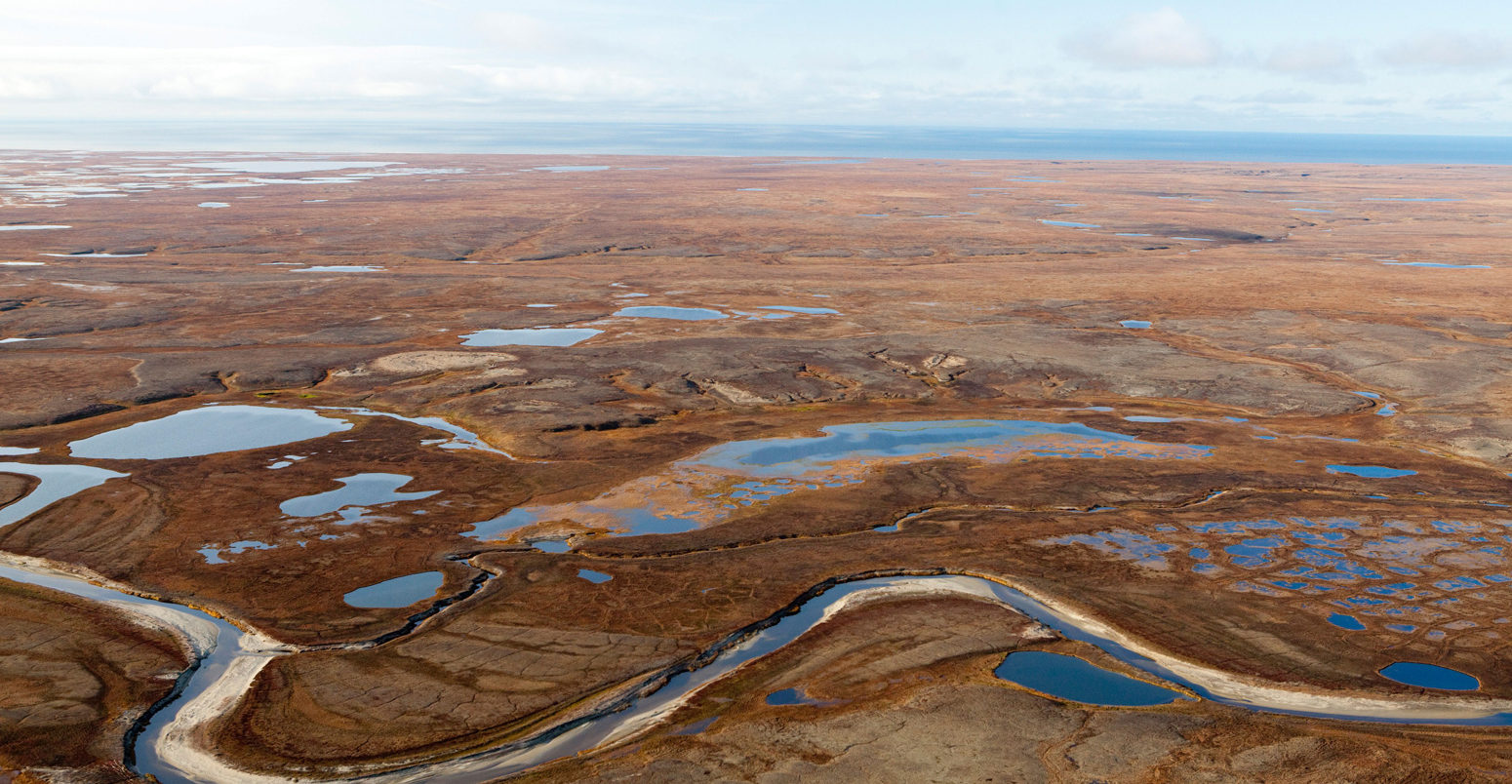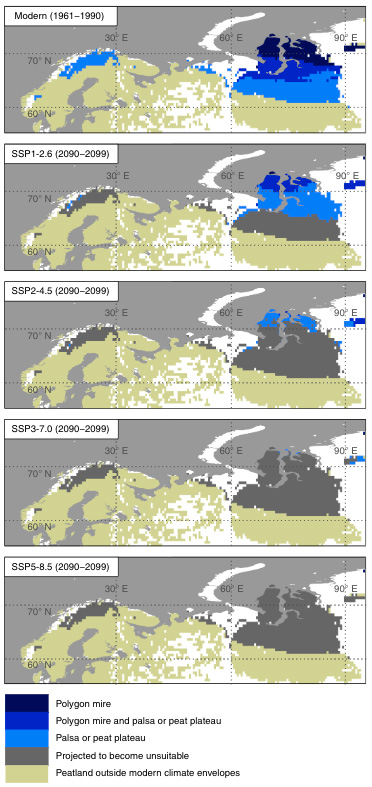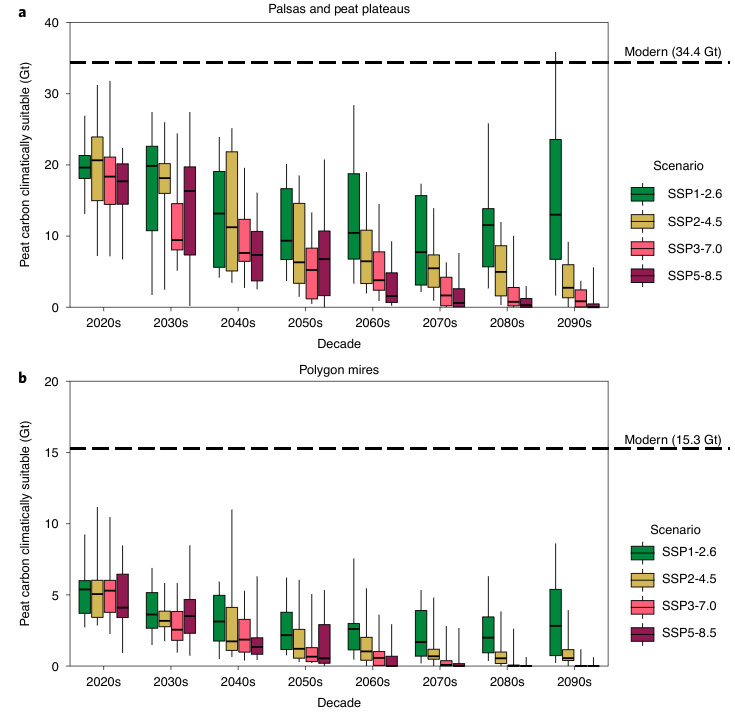
‘Imminent’ tipping point threatening Europe’s permafrost peatlands
Giuliana Viglione
03.14.22Giuliana Viglione
14.03.2022 | 4:00pmLarge swathes of northern Europe and western Siberia may become “climatically unsuitable” for carbon-rich permafrost peatlands within a few decades, even under moderate warming scenarios, a new study warns.
These carbon-rich landscapes span more than 1.4m square kilometres (km2) and contain around 40bn tonnes of carbon – about twice what is stored in Europe’s forests.
The study finds that under a moderate warming scenario, around 75% of this area could be too warm or too wet to maintain permafrost by the 2060s. However, the researchers stress, how much carbon is released – and over what timescales – is very much an open question.
They also warn that parts of northern Europe may be near a “tipping point”, past which its thawing peatlands cannot recover. But, they say, if strong climate change mitigation measures are taken, parts of western Siberia would maintain their suitable climate into the 2090s – and could even allow for new peatlands to form after warming peaks.
A researcher who was not involved in the research tells Carbon Brief that the study is “a crucial piece” in understanding the way permafrost peatlands will respond to a warming climate.
‘Tipping point’
Permafrost peatlands store some 185bn tonnes of carbon (GtC), accounting for nearly half of the soil organic carbon held in peatlands in the northern hemisphere. Beneath an “active layer”, which thaws and refreezes each year, the frozen ground locks away carbon that has accumulated over centuries and millennia.
Because they are perpetually frozen, these peatlands are highly susceptible to the effects of climate change. When formerly frozen peat thaws, microbes start to degrade the long-buried organic material. Depending on the conditions, this can release CO2, methane and other greenhouse gases to the atmosphere.
Researchers are particularly concerned about the possibility of reaching a permafrost “tipping point”. And while, in some cases, permafrost thaws slowly, under certain conditions, the landscapes can rapidly collapse.
Dr Christina Schädel, an ecosystem ecologist at Northern Arizona University, who was not involved in the study, tells Carbon Brief:
“Once temperatures become warmer, the microbes become active and they decompose the material that’s in there. So that carbon will be lost forever – and it would take way longer to get any additional carbon back into the ground.”
The greenhouse gases released to the atmosphere by the thawing permafrost then act as a positive feedback, further increasing warming.
However, Schädel adds: “It matters how far we get.” Although carbon loss from thawed permafrost is irreversible, halting warming can slow and potentially stop further thaw, as she detailed in a guest post for Carbon Brief in 2020.
The new study, published in Nature Climate Change, focuses on two types of permafrost peatland landforms: “palsas”, also known as peat plateaus, and polygon mires.
Palsas are raised mounds of frozen peat, ranging from several metres to several kilometres in diameter. They are patchy and are found further south than polygon mires. In contrast, polygon mires are continuous, frozen landscapes. They are found in the colder, drier regions of the far north.
Because of their small size, palsas are very hard to discern using remote sensing tools such as satellites, says Dr Carolina Voigt, a biogeochemist at the University of Eastern Finland who was not involved in the study. As a result, many of these features are “poorly mapped”, she says.
To determine the current extent of the peatlands, the researchers pored through the literature for descriptions and locations of palsas and polygon mires, and then mapped these coordinates. They focused their efforts on western Siberia and Fennoscandia – the region containing Norway, Sweden, Finland and parts of Russia.
Although vast amounts of frozen carbon are also found in other parts of Siberia and in North America, the data in those regions is less dense, making it hard to validate any modelling results, says Richard Fewster, a PhD candidate in physical geography at the University of Leeds, who led the new study.
Fewster and his colleagues matched up their peatland maps with previously published maps of soil organic carbon in order to determine how much carbon was at risk as the climate becomes less suitable for permafrost.
Suitable climates
To understand how the suitable range would change over time, the researchers employed a “climate envelope” model. By linking the presence of permafrost peatlands to different climate variables, they estimated the range of temperatures and precipitation that are suitable for each of the two permafrost landscapes.
They ran their analysis for a baseline period of 1961-90 and under a range of climate change projections from the latest generation of the Coupled Model Intercomparison Project (CMIP6).
Fewster and his colleagues selected a strong mitigation scenario (SSP1-2.6), two moderate mitigation scenarios (SSP2-4.5 and SSP3-7.0) and a very high emissions scenario (SSP5-8.5). (See Carbon Brief’s explainer for more on these scenarios.)
The figures below show how the suitable climate envelope is projected to contract under each of the four warming scenarios, with the shades of blue indicating the suitability for palsas, polygon mires or both.

Carbon at risk
Under the strong mitigation scenario, the models project a large reduction in the suitable envelope for permafrost peatlands in the coming decades, particularly in Fennoscandia. Over the course of this decade, they forecast a contraction of 38% in the area suitable for palsas; in Fennoscandia, the contraction is nearly 90% over that time.
The simulations show that the suitable climate space for palsas will continue to shrink by about 70,000km2 per decade until the 2070s. However, late-century cooling brought on by the strong mitigation methods could allow a partial recovery of the climate in western Siberia.
With this recovery, they forecast a net loss of suitable area by the end of the century of 58%.
But, even under this strong mitigation scenario, the models do not project a return to the suitable climatic space in Fennoscandia – suggesting, the authors write, that those peatlands are close to or have already passed a tipping point.
If these strong mitigation measures are not taken, the picture is even more dire, Fewster says. By the 2060s, 75% of the suitable climate envelope for palsas will be lost under SSP2-4.5. Under the highest emissions scenario, this grows to 93%.
The suitable climate for polygon mires will contract even more – between 93% and 99.9%, depending on the warming scenario.
By the 2090s, the area containing suitable climate for palsas will have contracted by 87%, 98% and 100% under the moderate, high and very high emissions scenarios. The authors note that there is “strong” inter-model agreement on these figures. This near-total loss of suitable climate will leave between 37GtC (SSP2-4.5) and 39.5 GtC (SSP5-8.5) at risk.
Unlike in the strong mitigation scenario, none of these scenarios offer any chance of climatic recovery, Fewster says. He tells Carbon Brief:
“The moderate mitigation scenario is going to ultimately lead to the same sorts of trajectories as those worst case scenarios, it’ll just take a bit longer to get there. We showed that actually it’s only that very strong climate mitigation scenario where we see a sort of a restriction of the areas that are going to become too warm and too wet.”
He adds:
“It really highlights that that strong climate mitigation scenario is very different from the others.”
The figures below show the amount of carbon stored in peatlands within the suitable climate envelope in each decade and for each warming scenario. The top panel shows the carbon in palsas, while the bottom shows that stored in polygon mires. The warming scenarios are colour-coded from SSP1-2.6 (green) to SSP5-8.5 (red). The black dashed line shows the amount of carbon stored under the “modern” climate conditions of 1961-90.

‘No real clear answer’
Importantly, Fewster says, their model says nothing about how much carbon will be released from these areas or over what timescale that release might happen. He tells Carbon Brief:
“Ultimately, it’s still unclear whether those peatlands will release a lot of that carbon, or whether subsequent increases to peat accumulation rates and plant productivity are going to actually offset some of those losses with new carbon being stored in the ground…We’re not saying that at that time period, it’s all going to disappear and it’s all going to be released. Because we can’t say that from our modelling, and it’s highly unlikely that that would be the case.”
However, there are several unknowns that cannot be accounted for in the study, Fewster says. The high organic material content of peat “acts as an insulatory blanket” for the soils below. This means there will be some time lag between when the temperatures surpass the climatically suitable range and when the permafrost thaws.
The magnitude of this lag is still highly uncertain. In some places, permafrost thaw has occurred over the course of a few years; in others, the permafrost has persisted for a decade or more. In Fennoscandia, where much of the landscape is already outside the suitable climate envelope, thawing peatlands are commonplace.
“In Finland, we observe this very well,” Voigt says. “It’s a process that’s already started.”
Another major unknown is how vegetation will respond. As temperatures increase, new landscapes may become more hospitable to plant life, which could offset some of the carbon lost from the peat.
And while Fewster hypothesises that current polygon mires may be transformed into palsas as the peatlands begin to partially thaw, this “hasn’t really been seen in the observational record before”, he tells Carbon Brief.
Voigt tells Carbon Brief that this northward migration of land cover types and vegetation is “interesting to think about”. She adds that other studies have not really addressed this possibility.
There’s “no real clear answer” as to how fast carbon would be released from the thawed peatlands, says Dr Kimberley Miner, a climate scientist at NASA’s Jet Propulsion Laboratory. Miner, who was not involved in the research, tells Carbon Brief:
“There’s a whole field of study working to answer that question.”
Several researchers who were not involved with the study praised the work for its thorough approach and for looking at a range of different mitigation scenarios.
Miner says it is “an interesting and important study” and that it was a “good application of both science and policy metrics”. She tells Carbon Brief:
“Looking at permafrost peatlands is critical to understanding the changing Arctic landscape. And this paper is another great step in that direction.”
Schädel also says that the policy focus is an important contribution of the work. She tells Carbon Brief:
“They didn’t just talk about how bad things are, they’re actually showing [that] if we go on the best path forward, we can protect a lot of the carbon that’s in there, and we can protect those ecosystems much better…I think for policy relevance, that’s important. You need to show what the impacts are, if you take action.”
Fewster, R. E. et al. (2022) Imminent loss of climate space for permafrost peatlands in Europe and Western Siberia, Nature Climate Change, doi:10.1038/s41558-022-01296-7.
-
‘Imminent’ tipping point threatening Europe’s permafrost peatlands
-
Europe’s permafrost peatlands ‘will soon surpass’ a tipping point

